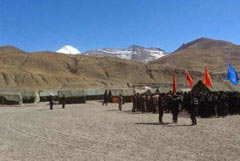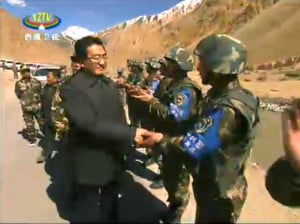- The Chinese authorities have tightened controls and deployed paramilitary troops to block Tibetans from making a pilgrimage to the sacred Mount Kailash in western Tibet and restrict travel in border areas. The moves are linked to the authorities’ objectives in preventing Tibetans from attending a major religious teaching, the Kalachakra, by the Dalai Lama across the border in Ladakh from July 3.
- The restrictions coincide with the important religious period of Saga Dawa, the anniversary of the Buddha’s birth, enlightenment and death, which this year falls on May 29-June 27.[1]

Troops gather near Mt Kailash last month.
Woeser, who lives in Beijing, cited a Chinese traveller who had been told by a travel agency that Tibetan clients were no longer able to obtain permission to travel in border areas of Tibet such as Purang (Chinese: Burang) where Mount Kailash is located.[2] The Chinese visitor was able to obtain the document because he applied in Guangzhou. Another Chinese netizen said the restrictions were likely to continue until August, and possibly until the end of the year.
Pilgrimage to Mount Kailash is of profound importance to Tibetan Buddhists, particularly during the holiest month of Saga Dawa (until the end of June). Tsering Woeser wrote: “I know a Tibetan exile who has been living in Switzerland for years, 60 years of age and in poor health. Long ago he made a wish to visit Mount Kailash on pilgrimage three times in his life, so he longed to circumambulate the mountain on the 15th day of the fourth month of the Tibetan calendar [June 13]. Even if he died walking the kora [pilgrimage circuit], it would be seen as the greatest liberation. His family is ready to help him fulfill his wish, but will he be able to do it?”

Deputy Party Secretary of the TAR Deng Xiaogang visited border security and PLA bases in May.
Deng Xiaogang, who is also secretary of the Party Committee on Politics and Law in the TAR, was cited by the state media as saying that border security checkpoints are key to maintaining social stability in the Tibet Autonomous Region and that security personnel should study Chinese leader Xi Jinping’s speech, with particular reference to his emphasis on maintaining social stability in Tibet and its importance to national security.
‘Patriotic education’, now commonly referred to as ‘legal education’ has also been stepped up in recent weeks in Pashoe county in Chamdo Tibetan Autonomous Prefecture, and the same Tibetan source said that monks and nuns now have to apply for permission even to go for prayers or to carry out religious rituals in the local area.
In common with other areas of Chamdo, Tibetans in Pashoe have to register with the local police to fill their cars with petrol. This has been the case in other areas of Tibet since the wave of self-immolations began in 2009. Tsering Woeser wrote: “In April [2013], the work groups went from house to house [in Chamdo] and confiscated monks’ or herdsmen’s remaining petrol or diesel used for cars and motorbikes. Since then, if one needs to buy petrol, one has to use one’s ID card to have a refuelling card issued; and only with this card can one now purchase petrol from a petrol station; without it, one will be refused. If Tibetans from other areas such as Sichuan or Qinghai come to get petrol they will definitely be refused.”[4]
Controls stepped up prior to Ladakh Kalachakra
In an apparent effort to deter Tibetan officials from travelling to attend the Kalachakra in exile, the Central Tibetan Administration reported that government officials in the Tibet Autonomous Region have been ordered not to take their annual leave from the month of April to September this year. According to a source cited by the Central Tibetan Administration website Tibet.net, government officials were told that if they were found taking leave during this time would be dismissed.
The Central Tibetan Administration, based in Dharamsala, India, said that the Chinese authorities had also stopped issuing new or renewing old passports to Tibetans, adding that those who have already obtained their passports in the past had been asked to submit it back to the authorities.
This follows the shift to a harsher and more systematic approach following the Kalachakra religious empowerment by the Dalai Lama in Bodh Gaya, India, in January, 2012, in which returning Tibetans were detained and compelled to undergo intensive ‘patriotic education’ sessions. Some were kept in prison or forced to do hard labor for longer periods, for instance if they were caught with photographs of the Dalai Lama or mementoes of the teaching.[5]
Around 7-8000 Tibetans from inside Tibetan attended this major teaching at the place where the Buddha was enlightened, a place of pilgrimage for Buddhists worldwide. But China extended its policies into exile, with Chinese agents operating on Indian soil gathering information about Tibetan pilgrims prior to their return.
The scale of the security operation had not been seen before following a Dalai Lama teaching in India, and it indicated the authorities’ concerns about a spread in unrest and Tibetan solidarity following a series of self-immolations and protests in eastern Tibet. The detentions and intensive ‘patriotic education’ also indicated a systematic implementation of the Party’s objectives in Tibetan areas since March, 2008, of tightening control in the context of a pervasive campaign to oppose the Dalai Lama and his influence.[6]
Footnotes
[1] The Buddha’s birth, enlightenment and entry into Nirvana at his death are observed together on the 15th day of Saga Dawa, which this year falls on June 13.
[2] Border registration permits are required for travelling to the following areas of the Tibet Autonomous Region: Shigatse (Chinese: Xigaze): Dengpa county, Saga county, Nyalam County, Shegar county, Kangma county, Yatung County, Gampa county, Tingkye county, Kyirong county. Lhokha (Chinese: Shannan): Tsona county, Lhuntse county, Lhodak county, Nakartse county. Nyingtri (Chinese: Linzhi): Miling county, Namshan county, Zayul county, Metok county. Ngari (Chinese: Ali): Purang county (where Mt Kailash is located), Tsada county, Rutok county, Gar county.
[3] Chinese state media footage of the visit at: http://www.vtibet.com/xw_702/sp/201405/t20140502_194365.html
[4] Blogpost by Woeser translated by High Peaks Pure Earth, June 14, 2013, translated by High Peaks Pure Earth http://highpeakspureearth.com/2013/chamdo-villages-and-monasteries-are-covered-in-five-starred-red-flags-by-woeser/
[5] For example, a Tibetan businessman was sentenced to two years of hard labor after he was found to be in possession of ‘illegal’ materials following his return from the Kalachakra; http://www.rfa.org/english/news/tibet/returnee-01172013143623.html
[6] Since protests spread across Tibet in 2008, to be met by a violent crackdown, the Chinese government has adopted a strategy of actively establishing Party presence in rural areas as the answer to ‘instability’. This has led to a more pervasive and systematic approach to ‘patriotic education’ and a dramatic increase in work teams and Party cadres in rural areas of the Tibet Autonomous Region. For further details, see ICT report, ‘Storm in the Grasslands: Self-immolations in Tibet and Chinese policy’, at https://savetibet.org/wp-content/uploads/2013/06/storminthegrassland-FINAL-HR.pdf

